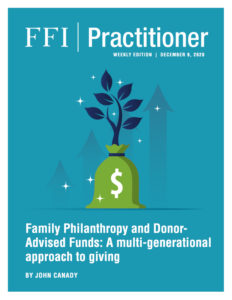
View this edition in our enhanced digital edition format with supporting visual insight and information.
In this week’s edition of FFI Practitioner, author John Canady examines how donor-advised funds (DAFs) can provide enterprising families an alternative to establishing a family foundation to accomplish their philanthropic objectives. In his article, John explores the potential benefits of creating DAFs, which vary by jurisdiction, for family enterprise clients.
Philanthropy is often a priority for successful enterprising families.
It is a way to give back today, to leave a legacy for the future, and to honor a family’s history and its values. Families can come together to fund causes over the long term and/or to gather in a crisis, such as COVID-19, to support relevant causes. Choosing the right giving vehicle for family philanthropy is important. Families can achieve greater impact when they use an efficient structure for their charitable giving. Outside of the US, many families assume that setting up a charitable trust or foundation is the only choice. However, many global families—often several generations spread across multiple geographies—are now turning to donor-advised funds (DAFs) and using them as the modern alternative to establishing a new grant making charitable foundation.
A donor-advised fund is a philanthropic fund established under a sponsoring umbrella charity that administers the fund on behalf of the donor. A DAF allows donors to make charitable contributions, to receive immediate tax benefits (if available in the jurisdiction), and to recommend grants from the fund over time. Families choose DAFs because of their flexibility and low-maintenance requirements. When a family utilizes a charitable trust or foundation, the family must handle the day-to-day operations, including regulatory reporting and grantee due diligence. Alternatively, when a family utilizes a DAF for its grant making, all compliance and reporting are handled by the DAF sponsor. If a family’s philanthropy focuses on making grants to charities (versus running operational programs), then a DAF can be the ideal charitable vehicle.
Using a DAF for family philanthropy is relatively straightforward. First, a DAF can usually be established in a matter of days, rather than the months required to set up a new foundation. The family chooses a name for its DAF, just as it would choose a name for a family charitable foundation. Then, the family names the advisors to the DAF. Since the DAF is not a separate legal entity, there is no separate board of trustees for the DAF. Instead, the named advisors have advisory privileges to recommend investments and grants. Once the DAF is open, the family donates assets to the DAF sponsor charity. Some jurisdictions provide tax incentives for these donations. The named advisors may then recommend how the DAF assets are invested and recommend grants from the DAF to any qualified charity around the world at any time.
There are several key questions that families should consider when deciding whether to use a DAF, a charitable foundation, or both:
Does the family want to be public or private in their philanthropy?
With a DAF, a family has the option to recommend grants anonymously. This may be useful if the family wishes to retain privacy around its giving at certain times.
Does the family want to use its philanthropic assets for impact investing?
Families are increasingly investing charitable assets for both financial and social impact return. DAFs can make impact investing easy. Families may wish to try out impact investing using DAF assets before integrating impact into their private wealth portfolios or disrupting the private foundation’s existing investment portfolio.
Are there family members who would like to take a leadership role in the future?
With a DAF, a family can involve the next generation. Children can be brought into decision-making conversations to encourage them to share in the family’s giving ethos and to become committed to making a difference. The next generation can also be involved in investment discussions—including making impact investments with the DAF assets—as a way to expose them to investments before they take their seat at the table managing the family’s overall wealth.
Does the family have an existing charitable foundation that isn’t meeting the needs of all family members?
Often, existing family foundations have specific charitable missions or areas of geographic focus. These do not always meet the priorities of each family member. Or families sometimes want to add an area of focus but cannot do it with the ‘mission lock’ of the current structure. For example, a family foundation may be restricted in its mission to focus on local childhood education, but the family may also wish to fund environmental causes. By opening a complementary DAF to use alongside an existing family foundation, the family has the flexibility to recommend grants from the DAF to support different issues or regions. Additionally, a family may wish to use a DAF to perform the necessary due diligence on international grants and to facilitate other complex grant making initiatives. Families often use a DAF to manage international grants in order to free up the administrative burden on the private family foundations. For global families spread across several geographies, the family may already have a foundation in its home county and use a DAF to manage their giving in other parts of the world.
What does the family want its legacy to be?
Successful families hope to make a positive impact that outlasts them. A DAF can be an excellent solution. There are three primary legacy succession planning options: 1) naming individual successors from the next generation to make grants from the DAF in the future, 2) designating specific charitable beneficiaries, or 3) establishing an endowment to distribute a portion of the DAF assets in annual grants to one or more charities. A DAF is flexible and can be used to ensure that the family’s philanthropic tradition continues.
In spite of their advantages, DAFs are not always the answer. Sometimes, families want their philanthropy to run specific operational programs. In this case, a separate charitable foundation may be necessary since DAFs can only make grants to qualified charities. DAFs cannot be used to run and manage operational charitable programs with staff, offices, etc. Also, families must be comfortable that they are ceding ownership and legal control of the assets to the DAF sponsor. But for most families, a DAF is a convenient and efficient alternative to establishing and running a new charitable legal entity.
Successful enterprising families spend significant time and effort planning how they will pass along their businesses and wealth to the next generation. These families also spend significant time and effort planning how to pass on family values. For many, family giving is central to expressing who they are. In today’s turbulent world with urgent needs, families are focusing more than ever on how they can give back and help others. DAFs can be used as a tool to help enterprising families achieve their philanthropic goals.
About the Contributor

John Canady is CEO of National Philanthropic Trust UK. He brings 25 years of experience working across the business, nonprofit and government sectors, specializing in creating and managing philanthropic funds for donors and family offices around the world who wish to base their philanthropy from the UK. He was awarded the Philanthropy Advisor of the Year at the Spear’s Wealth Management Awards in 2018.

View this edition in our enhanced digital edition format with supporting visual insight and information.



